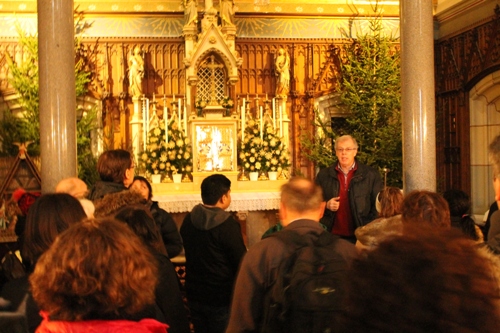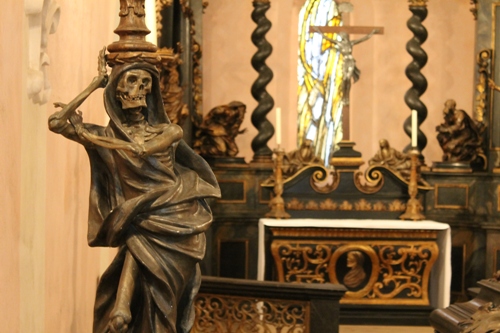We’ve been on quite a few lovely boat trips in our travels. And not all of them above ground, either – the Blue Grotto springs to mind. But, easily the oddest boat ride was had today.
We were part of a bus group, headed out into the southern Vienna Woods. We rather like leaving the city for one day and exploring a bit further afield. And, if you ignore the majority of other tourists with you on the bus, it’s generally quite interesting.
It didn’t start off too promising though. A mini-bus with blacked out windows picked us up in front of the hotel and whisked us off to the Opera House where we were transferred onto a huge, double decker bus.
At this point there was a bit of confusion. People were milling and asking questions in just about every language known to man (and a few unknown before today). I waved my ticket at him and asked “Mayerling?” and he nodded us aboard.
Mirinda decided we should go upstairs and walk the length of the bus before sitting down. She stopped and sat by the back stairs…which would have saved us a long walk.
The bus then took off…but not for long. We pulled up outside a big bus station about ten minutes later. There was then an announcement over the tannoy. Anyone going to the Vienna Woods should remain on the bus (phew) but anyone going on the Vienna City Tour should leave and get the bus next to us.
And so, our day trip started. We drove to the edge of the Vienna city limits and headed into the low hills. Through the lovely town of Baden (known for it’s natural spring water baths – hot in winter, hot in summer) and on to the hunting lodge, where Sisi’s son Rudolf killed, first his lover (Mary Vetsera) and then himself for reasons known only to him.
Actually I have my own theory about the mysterious death of Rudolf and Mary but I’ll not go into it here.
Anyway, shortly after the deaths, the crown gave the property to a bunch of Carmelite nuns who built a chapel and convent on the site. This chapel was our first stop.
That’s our guide for the day telling us about the chapel. Mirinda reckons he learnt his English in South Africa because of his accent. She might be right because his German just sounded German.
Anyway, we all traipsed through the chapel then the room with the lead coffin which may have been Mary’s, before heading back outside again. By the way, Mary’s coffin (and body) was dug up not long after her death by some chap who took it all home with him. It was then discovered and returned to the chapel. At least they think it’s the same one.
It was at about this point that I took a sudden dislike to the four children who were accompanying us on our journey. They were far too young to appreciate any of it and just made strange noises most of the time. One of them spent the best part of 15 minutes braying like a donkey.
Our next stop was the Cistercian Monastery at Heiligenkreuz. This was established by Margrave Leopold III of the House of Babenberg. He’d sent his son, Otto, to Paris so he’d get a decent education. Otto found out about the new Cistercian cult and was persuaded that he needed a load of them back at home.
He went to his dad, Leopold, and told him the latest fashion for any ruler was to build a big monastery somewhere on his lands. This would guarantee him not only a place in heaven but also a few mentions in guide books.
Clearly, Leopold found it difficult to deny his son anything and the monastery was built sometime shortly after 1133. Otto, on the other hand, was so taken by the Cistercians that he became an abbot at another monastery and was known as the “father of German historians” for his scholarly pursuits.
The stained glass above, might be Otto. It’s in the Fountain House (a room with a fountain in it, attached to an underwater spring which never stops running) and there’s supposed to be one of him there. Trouble is, the name isn’t included in the Latin. Not that it matters. Let’s just say it’s Otto and leave it at that.
We had a jolly good wander all over the monastery (the monks were busy doing other things, which is rather handy since tourists can’t just wander around when they’re about their daily routine of prayer, chanting, prayer, chanting, prayer and chanting) which was lovely…if I ignored the horrid little children that were rapidly getting up my goat.
Mirinda’s favourite bit was the room with the amazing inset wood panelling…
…but mine was the candle stick holders in the funeral chapel.
But the best part of the day was yet to come.
The bus pulled up outside a small shop with Seegrotte written across the entrance. This marks the extremely unassuming entrance to an old gypsum mine. Grey and red gypsum, for use as fertiliser, were mined here from 1848 until 1912. It was all very successful and, as far as I can tell, no-one lost their life.
Then, in 1912, a huge explosion saw the lower shafts of the mine flooded when 20,000,000 litres of water burst in from within the mountain creating the biggest subterranean lake in Europe. The mine, at this point, was then shut down. Interestingly, no-one was even injured during this, let alone died as a result of it.
In 1932, the local authorities realised they had a bit of a tourist trap on their hands and opened the mine up for visitors. And so it’s been since…well, apart from a period in 1944 when the Germans thought it would be a brilliant place to build the first, poorly designed rocket powered planes.
It wasn’t long before the planes rusted away and the tourists returned, as they’ve been doing ever since. As did we, today.
The long walk to the ‘rooms’ is sort of interesting as is the place where some plane parts were found but the best bit, easily, is the boat trip.
Imagine floating through an eerie, almost silent world with just a hint of music wafting around cavern walls. Imagine sitting in a boat that is powered by an electric motor but which makes absolutely no sound as you drift around. The water is perfectly clear, the air completely still. You can almost forget that you’re surrounded by about 20 strangers.
A wonderful experience that both of us enjoyed totally.
But that wasn’t the end of our amazing final day in Vienna. For dinner, Mirinda was determined we should eat at the Reichenberger Griechenbeisl and her dream was realised.
The building itself dates back to 1350 (that’s the first time it’s mentioned) and it’s been a restaurant since at least 1447 when it was an inn called Zum Gelden Adler (the Golden Eagle). And though it’s changed it’s name many times since, it’s always been an inn.
The food and the atmosphere are both terrific (my deer fillet mignon was simply divine) but more than this is their wall of autographs. Okay so some restaurants can brag about having Hollywood stars dining there and signing their names but not many can boast people like Mozart and Beethoven. But they both ate here, often, and have autographed the wall.
The place is divided up into all manner of little rooms, each with special things in them. For instance, one room had a piano being played all the time we were there and, according to Mirinda who went for a bit of a gentle roam, there was a zither playing in another room.
Today was the perfect finale to our Viennese Christmas.








I always live a boat trip. How I’d like our own little boat so we could explore all the bis and outs of the underground lake. It was quite magical and relaxing.